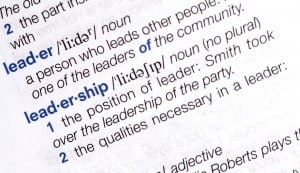Have you ever considered yourself a leader? How do you know? How can you be more aware of your influence in the workplace and strive to be better?
You may already be empowering others around you by simply being yourself.
What is Leadership?
Leadership is viewed by many as a hierarchical mountain. The leader sits perched at the summit and shouts directives to the masses below in the canyon. However, leadership is in fact not dictating orders from the top down but, by its definition, is the ability to take people somewhere….to transcend their current state whether it be:
- moving collectively towards a unified culture,
- reaching production goals through teamwork, or even
- maintaining morale during an arduous business cycle.
Deanne N. Den Hartog and Paul L. Koopman uniquely display a collection of scholars who have defined leadership over the years in their 2011 article Leadership in Organizations. All the cited scholars focus on influence and motivation yet none mention the use of authoritative power. Here are a few examples:
- Leadership is the process of influencing the activities of an organized group toward goal achievement (Rauch & Behling, 1984).
- Leadership is defined in terms of a process of social influence whereby a leader steers members of a group towards a goal (Bryman, 1992).
- Leadership is the ability of an individual to motivate others to forego self-interest in the interest of a collective vision, and to contribute to the attainment of that vision and to the collective by making significant personal self-sacrifices over and above the call of duty, willingly (House & Shamir, 1993).
What Defines a Leader?
Leaders come in all forms and are not bound by any one particular physical attribute or social class. In fact, “most [leaders] do not even consider themselves to be leaders; they’re just doing their job.” (Kwok-Sze Richard Wong, ED.D., 2013)
But, there must be some underlying feature that defines a leader, right?
In 1948, Dr. Ralph M. Stogdill conducted a study to identify the core personality traits that define leaders. He determined there were eight traits that contributed to becoming a leader but, more importantly, Stogdill concluded it was impossible to define any individual personality trait that distinguished leaders from followers.
Additional studies have been performed over the years, including a followup study by Stogdill in 1974, to search for the common trait in a leader but not a single personality trait has been singled out.
Kirkpatrick and Locke performed a study in 1991, Leadership: Do Traits Matter?, that concluded there are six personality traits (drive, motivation, integrity, confidence, cognitive ability, and task knowledge) that “individuals can be born with […] they can learn them, or both”; however, “the possession of [these] certain traits alone does not guarantee leadership success”.
While one personality trait does not distinguish the leader, there are various skills that consistently appear within those who lead and they may not be what you think.
Pause from this article for a moment to ponder what skills one may possess as a leader that extend beyond the personality traits.
Servitude.
Social interaction.
Did you guess either of these?
If not, you may be wondering how any of these are skills alone define leadership. However, these skills are quite literally at the heart of the matter when it comes to being a leader and is categorized under Social Intelligence.
Social Intelligence
Michael Hyatt, former Chairman and CEO of Thomas Nelson Publishers (& whose office was down the hall from ours), argues that while most leaders believe the top tools for success are experience, education, and charisma it is the heart that is the most significant tool. Furthermore, studies conducted since the 1990’s indicate that the social ability overshadows all the personality traits and is the “key trait for effective leaders” (Northouse, 2007).
A person who has some or all of the leadership personality traits will be ineffective without the ability to analyze the social situation.
This undercurrent of social intelligence allows leaders to understand “when to select and enact the best response given the contingencies of the situation and social environment” (Zaccaro, 2002). In fact, Harvard Business Review states “Claudio Fernández-Aráoz found in an analysis of new C-level executives…that those who had been hired for their self-discipline, drive, and intellect were sometimes later fired for lacking basic social skills” (HBR, 2008).
Servitude
Leading through service allows for better communication within the corporate structure, reduces bureaucracy, and provides an avenue for all employees to engage directly in the corporate mission.
Not all acts of leadership require a top-down decision process. Embracing collaborative brainstorming not only provides alternative solutions but also creates a culture of purpose for everyone.
Tweet: Take a back seat and encourage others to provide ideas and input for a change.
This open dialogue process allows team members the opportunity to fill their inner desire to belong, voice their opinion, and enhances the collective team spirit. Furthermore, it minimizes bureaucracy by encouraging team members to resolve problems openly, collectively and, most importantly, directly.
Instilling this mindset throughout the organization can reduce the amount of time employees spend seeking approvals for tasks they are quite capable of accomplishing without oversight.
Finally, leaders who demonstrate a commitment to the growth of their employees have been found to experience positive organizational outcomes (Barbuda & Wheeler, 2006). The results are in and the data tells us that compassion is a skill that can be cultivated! Yes, compassion can be learned and used altruistically to motivate employees towards unlocking their potential.
“Our fundamental question was, ‘Can compassion be trained and learned in adults? Can we become more caring if we practice that mindset?’” says Helen Weng, lead author of the study and a graduate student in clinical psychology. “Our evidence points to yes.”
Social Interaction
Leaders must engage in social interaction as well as promote the behavior within the workplace to maintain a culture where creativity excels and departmental and organizational barriers are at a minimum.
Simple engagements such as a brief chat at the water cooler, hearing the non-work stories of employees, and actively joining in various departmental group meetings help breed “enhanced collaboration, higher metacognition, richer sensory experience by way of emotion, better planning where each member feels included, and a better understanding of common value and purpose” (Agarwal, 2010).
Social Capital Theory originated in the 1960’s as an exploration of personal relationships and the concept has thus been applied to various social structures from family units to the workplace environment. The theory states that a social network has value whether it be intangible such as a productivity benefit or a tangible economic benefit.
In 1998, Tsai and Ghosalhal proposed that someone centrally located within various departments “has greater potential to combine and exchange resources”. Therefore, it seems negligent for a leader to avoid interacting with teams and individuals.
The Quantitative Analysis of Intra-organizational Knowledge Sharing thesis by Madeleine Block proved Tsai and Ghosalhal’s theory that intra-organizational interaction ties “serve as a determinant of shared vision and also for perceived trustworthiness”. Thus, leaders who interact authentically on the individual and departmental level can increase the shared vision of the company and establishing/maintaining the culture.
Self Awareness
Self-awareness is the starting point for learning social intelligence. One of my favorites soundbites from Daniel Goleman sums up why starting with yourself promotes your outwardly expression. Goleman says, “To be authentic is to be the same person to others as you are to yourself.” (HBR, 2013).
One can use assessments to identify your Emotional Intelligence as well as connect to your inner self by practicing mindfulness. Fully understanding yourself and being able to see where or to whom you should serve within the organization is essential to properly implementing servitude and social interaction.
How do you become better, more self-aware? Take action. Be mindful. Learn who the true you is and cultivate your compassionate mind. Your authentic self is the key to becoming an effective leader.
Let me know your stories of embracing mindfulness and increasing your social intelligence.






